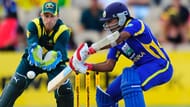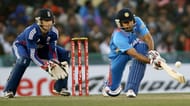In the game of cricket, whenever the batsman hits the ball over the boundary, he/she is awarded six runs. No matter how far the ball travels beyond the boundary, not more than six runs are added to the batsman’s tally. Similarly, four runs are awarded if the balls reaches the boundary after landing on the ground; it doesn’t matter how fast the ball travels or how many times the ball bounces to reach the ropes. So, with a considerable amount of speculation, one can assume that this normalization was made in order to nullify physical advantages of some of the players, unlike those in some other sports such as running, cycling etc. No wonder, Virat Kohli can’t hit it as far away as Mahendra Singh Dhoni does. Yet, both of them are outstanding batsmen with a great caliber of winning the match on their own, and thus are ranked at commendable 3rd and 4th positions in the latest ICC ODI rankings.
In this bang bang T20 generation, the likes of David Warner, Kevin Pietersen, Brendon McCullum, Kieron Pollard etc are sought after as the run (and money) making machines, thanks to their enterprising knocks and hard hitting abilities. When on song, they send the balls on airborne missions out of the park and entertain the spectators with some clean smacks over the boundaries. But on other occasions, their dismissals can look ridiculously stupid, such as a being caught off a mistimed loft straight above the head, being bowled with the stumps uprooted while playing a heave across the line, being stumped out by a three feet large distance from the crease, etc. Such is the risk factor in their conversion ratio to a bigger score that they can get away in the shortest format but not in ODIs and Tests, where heavy scores are required and not strike rates.
In comparison, the consistent batsmen of this particular era share certain common traits – they put a price on their wicket, work out the fielding placements, play to their strengths, do not take unnecessary risks to play extravagant shots, build good partnerships, keep the score board ticking, play till they finish the games. These attributes are so essential in any format of the game as shown by some of the performers now-a-days – Virat Kohli, Alastair Cook, Hashim Amla, Michael Clarke etc.
The concept of timing the ball and placing it between the gaps is a batting mantra since time immemorial. A straight drive from the middle of the bat for four runs is always a more pleasing scene than a leading edge for six in the third man region. Shot selection is such a key ingredient in any batsman’s innings – it can break or make it. In the recent T20 match between Australia and Sri Lanka, the way Mahela Jayawardene manipulated the bowlers on a slowing Melbourne surface was a treat to watch. Put into bat on what looked like a good batting track, Sri Lanka suffered early blows as they lost three quick wickets for 39 runs in the seventh over.
At this juncture, Mahela Jayawardene played an anchor’s role in partnerships with Jeevan Mendis and Tushara Perera by rotating the strike and punishing loose deliveries. At the closing stages of their innings, Mahela played some glorious shots that would leave any spectator with a sense of awe. The precision with which he lofted an inside out drive over extra cover for six was a real moment to cherish; he did not try to over hit it – it was an act of sheer timing. But the highlight of the innings were the three boundaries behind the wicket, utilising the pace of the ball and placing it between the fielders. These efficient strokes pushed the Lankans to reach an above par score of 161 runs. Sri Lanka won the match by two runs (Duckworth Lewis revised) after the second innings was reduced due to rain.
Beauty is to women as elegance is to batsmen. The elegance of a batsman is a symbolization of his/her batting poise, class and style. Slogging shots or monstrous heaves may fetch runs but they never look stylish or elegant. It is the proper cricketing shots that tend to show off this flair. And it is these elegant kind of batsmen whom you would usually try to emulate. Batting maestros such as Sachin Tendulkar, Brian Lara and Ricky Ponting fall into this category. They don’t boast of heavy physiques but they play masterful strokes with great ease. One such batsman is Rohit Sharma. He enjoys great support from his skipper MS Dhoni for this very reason. His 83 at the top of the innings in the fourth ODI of the recently concluded India vs England tour is one such example. The off drives, pull shots and lofted drives seem so calculated that you would begin to wonder if it is the best way to play those shots.
There are other wonderful batsmen in the history of the game who had thrived on pure stroke play and made great number of runs. VVS Laxman and Rahul Dravid are great ambassadors of the game in this regard. Such was the patience and shot selection of the duo that during the 2003-04 Border Gavaskar Trophy, players of that great Australian era were in complete awe of their performances. Justin Langer even commented about being under pressure as they were expected to play for spending time at the crease rather than making runs in the middle. Indeed, a 1-1 series result was an achievement for India in those conditions.
Glory is not in hitting two sixes off consecutive deliveries and getting caught on the boundary attempting the third, but it is in grinding a matured half century or a century that ensures the team’s victory.The conservation of a batsman’s energy is in converting most of the opportunities, rather than overdoing for some part of it.
Follow IPL Auction 2025 Live Updates, News & Biddings at Sportskeeda. Get the fastest updates on Mega-Auction and cricket news



